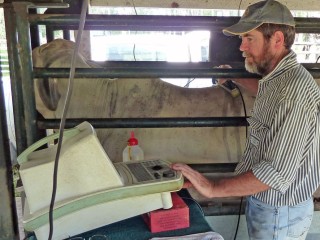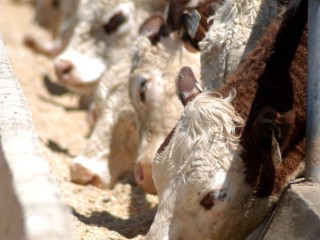 Key industry stakeholders are likely to meet soon to consider options for maintaining research and development momentum, following Thursday’s announcement that the Beef CRC will not be included in the next round of Federal Government CRC funding.
Key industry stakeholders are likely to meet soon to consider options for maintaining research and development momentum, following Thursday’s announcement that the Beef CRC will not be included in the next round of Federal Government CRC funding.
The decision (see Thursday’s story, “Beef CRC fails in fourth term funding bid”) will leave a $20 million hole in industry R&D financial support over the next five years.
CRC for Beef Genetic Technologies chairman Guy Fitzhardinge said he thought the result was possibly predictable, but was nevertheless a very disappointing outcome, which reflected attitudes towards R&D in the agricultural sector more generally.
“But agriculture is one of the areas where R&D can make a big difference. And in the case of the beef industry, where we see improved fertility, improved eating quality and improved performance, it is a relatively cheap way to make financial gains,” Dr Fitzhardinge said.
However as a percentage of overall industry value, relative to other sectors, the beef industry itself did not put a lot of money into R&D, and possibly the Commonwealth had been looking for evidence of a greater contribution, in order to renew CRC funding a fourth time, he speculated.
Comments like this suggest the industry itself may have to reconsider its depth of financial commitment to R&D work, and that the days of more ‘complete’ government support for R&D may be coming to a close. If R&D work is in fact considered of value to the industry then it may need to consider making a greater contribution through its own stakeholders.
One avenue could be raising more funds through an elevated R&D component in the cattle transaction levy. While it is obviously much too late to consider a levy change vote at this year’s MLA annual meeting, it could gain momentum in industry discussion for 2012.
Beef CRC chief executive officer Heather Burrow said above all else, she felt that the protection of the collaborative model under which the CRC had operated so successfully was a ‘crucial’ first priority in the period after the current CRC Mark III concludes on June 30 next year.
“We’re going to get greatest output for the industry if we can maintain a coordinated approach, despite the absence of CRC funds,” Dr Burrow said.
Part of the solution seen both by Drs Burrow and Fitzhardinge is in greater international collaboration in some areas of beef R&D.
“In the work we’ve been doing in the genetics area, for example, I don’t believe that any country will achieve the outcomes they are looking for on their own. If they do, it will be a very expensive and slow process,” Dr Fitzhardinge said.
“Just in terms of the discovery herds and the validation herds and the amount of money that can go into them, we need to be working in a more cooperative way with our international partners,” he said.
“I don’t believe that is getting in bed with our competitors: the reality is that the country that makes the most progress is the one that adopts the technology sooner and quicker than the others. And Australia cannot afford to slip behind in the rate of progress. Only very small incremental gains on each individual animal can amount to a huge dividend when applied across the nation’s or a region’s entire cattle population,” he said.
The concept of greater international collaboration had been floated with the scientific communities in North and South America and Europe, and there had been a reasonably enthusiastic response. But how it would work and what it might look like, and Intellectual Property accessibility were the more complicated issues.
Apart from greater international collaboration, Drs Burrow and Fitzhardinge said other models or aspects in the ‘post-CRC’ era might include the adoption of a ‘CRC lookalike’ structure within Australian stakeholders, which functioned much as the current CRC does, but without government funding.
That might come in the form of cash or in-kind contributions, in some cases from groups like breed societies, large pastoral companies, or goods or service providers.
The areas of R&D that might come under greatest threat might not be applied research, but long-term fundamental research that could be expensive and time-consuming to do and which might, or might not deliver outcomes, Dr Fitzhardinge suggested.
Dr Burrow said unless alternative sources of funding were found, the absence of CRC funds would mean the industry’s critically important genomic selection work could take “20 years longer to complete.”
In its original submission for another five years of Government support, the CRC for Beef Genetic Technologies said its aim would be to add $179 million to the value of the Australian and New Zealand Beef industries each year from 2012. That would be delivered through the program’s focus on world-class gene discovery and gene expression research to improve profitability, productivity and animal welfare outcomes.
Several key areas of research were likely to come under pressure from the reduction in the funding pool, Dr Burrow said.
“Essentially CRC Mark IV was going to help improve productivity through a combination of increasing throughput and reducing costs,” she said.
“We are at the stage where we feel confident in delivering value through genomics work now, but over the next five years, we could have added-in the sequence that would have greatly increased the accuracy for breeding selection purposes. We’re also at the stage where the technology is close to being able to be applied to identify and manage certain groups of animals through the production chain – those worth or not worth long-feeding, for example.”
Impacts on northern & southern Australia
 In Northern Australian applications, the CRC was close to having tests to be able to identify heifers at weaning or branding that had a genetic propensity to calve every year, without suffering from post-partum anoestrus. That group could be managed to effectively get them in calf at 15 months of age, adding greatly to overall calving rates.
In Northern Australian applications, the CRC was close to having tests to be able to identify heifers at weaning or branding that had a genetic propensity to calve every year, without suffering from post-partum anoestrus. That group could be managed to effectively get them in calf at 15 months of age, adding greatly to overall calving rates.
In Southern Australia, issues likely to come under pressure included the ability to identify at a young age those animals likely to marble well, or have the ability to meet MSA 4 or 5 star requirements.
“Using genomics we’re also close to being able to improve MSA compliance rates in Northern Australia as well,” Dr Burrow said.
Dr Burrow said her first response on receiving Thursday’s notice of advice was to contact industry partners, to brief them about the options that might exist for alternative sources of funding.
“If the CRC is to go for those alternative sources, however, it will need to be led and championed by industry,” she said.
“We already have that common submission through our fourth-round application for CRC support, and that is something that we can certainly build on. But it is going to need strong support from industry to do that,” she said.
Dr Burrow said the options open to industry were really quite simple.
“We can either accept the Federal funding decision and simply try to cut our cloth to suit in terms of future R&D activity; or we try to grow the pie,” she said.
“But to take the former option would mean that all beef research would suffer, I suspect,” she said.
Meetings are likely to be convened in coming weeks among the four key industry partners – MLA, Cattle Council of Australia, Australian Lot Feeders Association and Australian Meat Processors Corporation, to discuss the options.
Dr Burrow said CRC stakeholders were already looking at alternative models for Federal funding support. One of these was the Defence Materials Technology Centre, which operated very much like a collaborative research centre. The DMTC was funded through a range of federal and state government and industry sources. While the program itself had nothing to do with agriculture, it could provide a ‘look alike’ model which the Beef CRC could seek to emulate, in an effort to protect against more serious funding revenue loss.
Another option likely to be examined might be working more directly with commercial private sector industry groups.
Dr Burrow said she hoped a plan or model for future R&D could be put together by the end of September, around which funding avenues could be explored.
Whatever the model, it was likely there would be some R&D casualties, she suggested. That might mean fewer projects, a reduction in the scope of projects, or most likely of all, a combination of both.
“Much will depend on the amount of alternate funding that can be found. If we were dependent on industry funds alone, then both would have to decrease substantially, or be deferred,” she said.
The Beef CRC has been one of the more long-running commercial CRCs to operate in Australia. The beef industry was unsuccessful in the very first CRC round in the late 1980s, but was supported in round-two, starting in 1993.
The original Government advice was that the program could run for seven years, before reverting to some form of industry model. However the Beef CRC managers successfully argued for two seven-year extensions, based on new program directions. The program is now in its 20th year.
In 2008 a review of the Government’s CRC funding model came up with a ’15 year maximum’ rule, but that only applied to newly-established CRCs, and was not made retrospective.
On this basis, the Beef CRC pressed-on under a ‘merit-based selection’ argument in a fourth round application, hopeful of further funding support for another five years.
“Now that we have lost that support, we will certainly have to think creatively,” Dr Burrow said.
“That’s why we’re suggesting looking at plan B might involve looking at other sources of funding – government or commercial sectors, or even international collaborative work with researchers overseas.
“But one of the problems with collaborative work in genomics with the US, for example, is that Australia’s production systems are often so different from the rest of the world. Simply adopting North American genomic technologies into Australia might do the local industry a disservice, unless they are tested under our own production systems. That applies particularly in northern Australia.”
Dr Burrow said there was also an associated risk that young scientists working in the meat and livestock fields might become disillusioned with future research prospects in beef, given the CRC decision.
“They could be lost to the industry – either accepting work in similar fields overseas, or applying their skills in unrelated fields in Australia.”



HAVE YOUR SAY